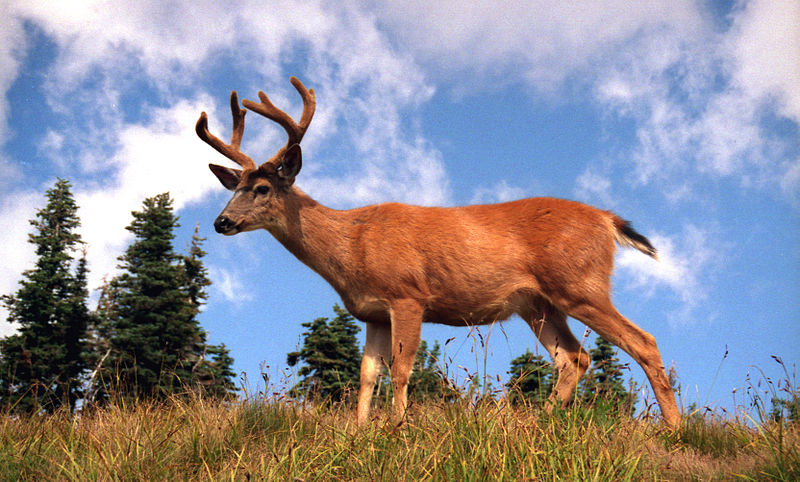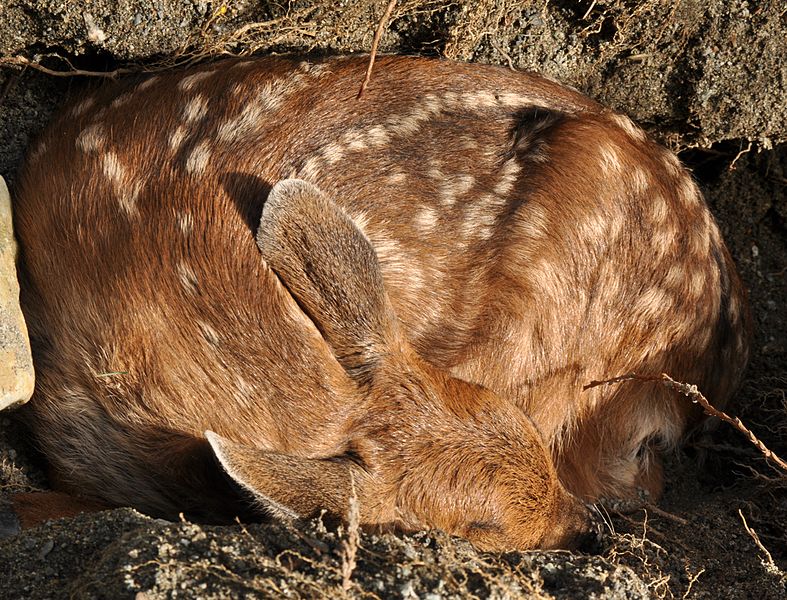
Reproduction and Life History
The
Columbian black tailed deer (Odocoileus hemionus columbianus)
reproduces sexually (WDFW 2013). Black tail deer are a part of
the (insert group ) which entails sexual reproduction. Sexual
reproduction is defined as when a female egg and a male sperm go
come together in fertilization creating a zygote. The zygote is
genetically different form the parents (Biology Online 2010).
Sexual reproduction occurs during the mating season in autumn.
This season is called the rut (WDFW 2013).

The rut will begin once the rubbing of the velvet from the male black tailed deer antlers’ has been completed. To learn more about antlers and rubbing go the adaptataions page. Once the rubbing has been completed it is a sign to all other male black tailed deer that the competition of the rut had begun (WDFW 2013). During the rut male black tailed deer show male ranking by visual display of imitation or by having head to head antler battles (Gross 1983). The male black tailed deer will than mate with multiple female black tailed deer during the rut. Once the rut is complete the male black tailed deer will have no connection with the fawn that was just created (WDFW 2013).
During the rut the female black tailed deer are in heat or otherwise known as the estrous cycle for 22-29 days. The gestation period is 7 months long so around 203 days (Thomas and Cowan 1975). Birthing season is expected to be as early as May or as late as October. Even though the birthing season is long, normally 85% of fawns are born with 32 days of each other (Encyclopedia of Life 2013). The fawns are born in an isolated bed of tall grasses (WDFW 2013) .
A yearling female black tailed deer normally will have a single
fawn. An adult female black tailed deer will have twins the
years that follow (WDFW 2013). When the fawn is born it has an
average weight of 8 pounds. Male and female fawns tend to have
the same weight at birth, unless there are twins with the
opposite sex. Than the male fawn of the twin set will weigh more
than the female fawn (Encyclopedia of Life 2013). Newborn
fawn(s) will have white spots coving its back for camouflage in
the isolated bed (WDFW 2013). The newborn fawn(s) will stay
secluded in its isolated bed for 6 to 8 weeks. This time period
is called the hiding period.(Encyclopedia of Life 2013). During
this time the female black tailed deer will produce milk for the
fawn from there mammary glands. . The milk provides a diet of
fats sugar proteins minerals and vitamins (Campbell et al.
2008). After the second week of the hiding period the fawn will
start eating green vegetation (Encyclopedia of Life 2013).
have twins the
years that follow (WDFW 2013). When the fawn is born it has an
average weight of 8 pounds. Male and female fawns tend to have
the same weight at birth, unless there are twins with the
opposite sex. Than the male fawn of the twin set will weigh more
than the female fawn (Encyclopedia of Life 2013). Newborn
fawn(s) will have white spots coving its back for camouflage in
the isolated bed (WDFW 2013). The newborn fawn(s) will stay
secluded in its isolated bed for 6 to 8 weeks. This time period
is called the hiding period.(Encyclopedia of Life 2013). During
this time the female black tailed deer will produce milk for the
fawn from there mammary glands. . The milk provides a diet of
fats sugar proteins minerals and vitamins (Campbell et al.
2008). After the second week of the hiding period the fawn will
start eating green vegetation (Encyclopedia of Life 2013).
The fawns typically do not move away from their bed unless they
are being nursed by their mother or eating green vegetation.
Mother black tailed deer protect their fawn by making sure there
is limited scent around the bed. This is accomplished by the
mother digesting the urine and feces of the fawn(s). This
benefits the mother by giving her much needed nutrients (WDFW
2013). The fawn will than stay by the mother’s side for the
next year until the next rut begins and maybe even longer.
That fawn will grow into a full fledge adult. In the wild male black tailed deer live on average to the age of 8 years old. The female black tailed deer live on average to the age of 16 years old. The oldest female black tailed deer found in the wild was 20 years old. The oldest male black tailed deer found in the wild was 19 years old. The maximum life of a black tailed deer that has lived in captivity has been recorded was a 22 years old male black tailed deer. The oldest female black tailed deer that lived in captivity has been recorded at 16 years old (Encyclopedia of Life 2013).
Refresh your memory on the
Nutrition page
or continue on and learn about Interactions
between species.
Go to
MultipleOrganisms.net.